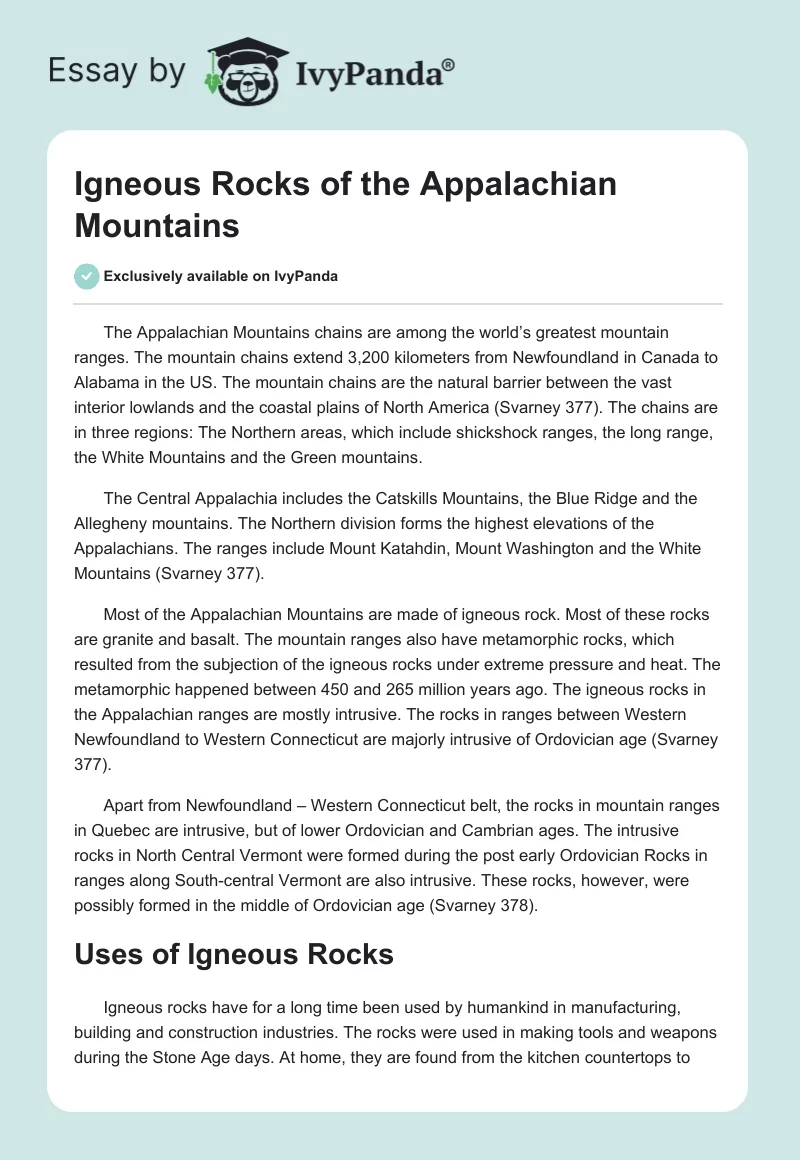The Appalachian Mountains chains are among the world’s greatest mountain ranges. The mountain chains extend 3,200 kilometers from Newfoundland in Canada to Alabama in the US. The mountain chains are the natural barrier between the vast interior lowlands and the coastal plains of North America (Svarney 377). The chains are in three regions: The Northern areas, which include shickshock ranges, the long range, the White Mountains and the Green mountains.
The Central Appalachia includes the Catskills Mountains, the Blue Ridge and the Allegheny mountains. The Northern division forms the highest elevations of the Appalachians. The ranges include Mount Katahdin, Mount Washington and the White Mountains (Svarney 377).
Most of the Appalachian Mountains are made of igneous rock. Most of these rocks are granite and basalt. The mountain ranges also have metamorphic rocks, which resulted from the subjection of the igneous rocks under extreme pressure and heat. The metamorphic happened between 450 and 265 million years ago. The igneous rocks in the Appalachian ranges are mostly intrusive. The rocks in ranges between Western Newfoundland to Western Connecticut are majorly intrusive of Ordovician age (Svarney 377).
Apart from Newfoundland – Western Connecticut belt, the rocks in mountain ranges in Quebec are intrusive, but of lower Ordovician and Cambrian ages. The intrusive rocks in North Central Vermont were formed during the post early Ordovician Rocks in ranges along South-central Vermont are also intrusive. These rocks, however, were possibly formed in the middle of Ordovician age (Svarney 378).
Uses of Igneous Rocks
Igneous rocks have for a long time been used by humankind in manufacturing, building and construction industries. The rocks were used in making tools and weapons during the Stone Age days. At home, they are found from the kitchen countertops to floor tiles (Stille 7). This widespread application of igneous rocks depends on their rigidity from weather changes.
Construction industry cut the rocks from quarries of gabbro, granite, pumice, rhyolite, basalt and other igneous rocks. The rocks are then crushed into gravels which are easily used for construction. The gravels can be used as the support beneath the concretes of the highway and in the formation of railroad track beds. Instead of crushing, the New Hampshire construction industries cut the rocks into blocks, which are then polished (Stille 8).
The polished blocks are sold to be used in monuments and on the fronts of buildings. The course grains on the block rocks make beautiful patterns on these structures. Unlike granite, rhyolites have smooth grains forming solid color. This quality makes them lack patterns as seen in granites. When polished, rhyolites are used as kitchen countertops, landscaping and on the outer surfaces of structures. Polished slabs of gabbro are used in memorial markers in graves and cemeteries. On the other hand, basalt has been used to make figurines, stone weapons and decorative objects (Stille 8).
Pumice igneous rocks are used as abrasives in processes that involve polishing and grinding. Pumice is also used in stone washing of jeans and other denim clothing. The abrasive action of pumice on the denim products gives them their worn-out look. Pumice is as well used in the making of sandpapers. Crushed basalts are melted in a furnace which are then pulled to thin strands. The strands are made into fiberglass used in home, offices or school insulation (Stille 8).
Works Cited
Stille, Darlene. Igneous Rocks: From Fire to Stone, Minneapolis: Capston, 2008. Print.
Svarney, Thomas. The Handy Geology Answer Book, Canton: Visible Ink Press, 2004. Print.


